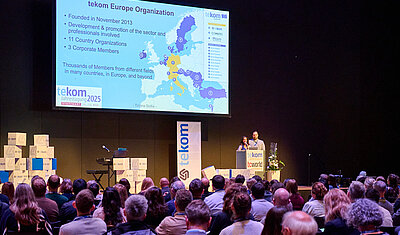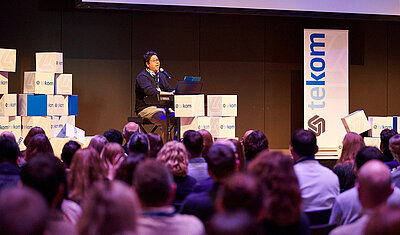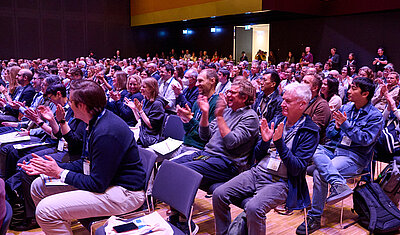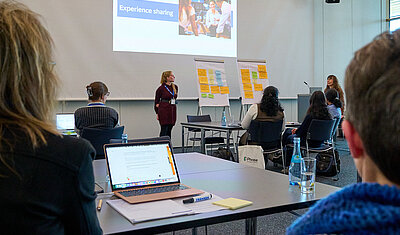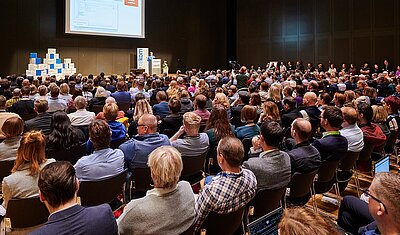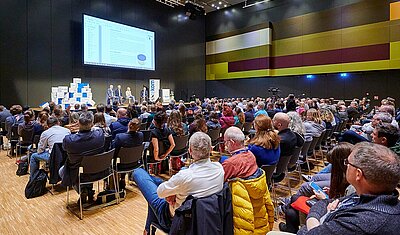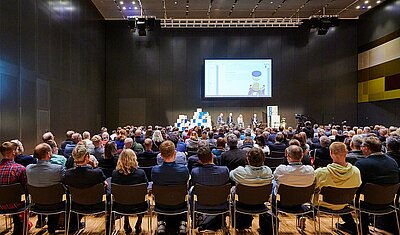Popular topics and lectures
A total of 200 technical presentations, workshops, and tutorials filled the three-day program of the tcworld conference 2025. The range of topics was impressive: from content strategy and information architecture to language and translation technologies, software documentation, and modern publication processes, the conference offered a broad spectrum of knowledge and opportunities for exchange.
A central theme this year was the use of artificial intelligence in technical communication. The focus was on issues of automation, semantic networking, and support for editorial and translation work processes. Above all the key question hung in the air: How can technical communication benefit specifically from AI?
Right at the start, Tiangkai Feng, Director of Data and AI Strategy at Thoughtworks, generated absolute enthusiasm among the audience with his inspiring keynote speech "The importance of language in working with Data & AI." He creatively combined the topics of language, data, and AI, using unusual means such as music and memes to impressively illustrate the importance of precise language use when working with artificial intelligence.
An inspiring tutorial was held on Tuesday entitled "From trends to mandates and job profiles: Technical communication as a designer in the company," presented by Isabelle Fleury (Managing Director of tekom Germany) together with Maximilian Tauchnitz. It became clear that with the advent of new technologies such as AI, expectations of technical editors are also rising – they no longer just have to write operating instructions, but also manage training materials, UX texts, and AI-supported content. In this context, Fleury said: "New mandates are emerging – they no longer only must write information, but about strategic roles, responsibility, and influence within the company." She pointed out that the professional field is expanding and new qualifications are required – and that technical editorial teams should actively shape this change, for example through targeted personnel development and strategic qualification measures.
Legal and normative developments were also a major focus. Current legislative changes, product safety issues, standards, and eco-design aspects were critically examined. Particularly noteworthy sind Gabriela Fleischer's presentation on the new EU Directive (EU) 2024/1799 on the right to repair and Jens-Uwe Heuer-James' presentation, which clearly summarized the latest legal trends in technical communication. "The digital product passport (DPP) is a new instrument that is much more than just a data collection tool: It will become the central interface between manufacturers, supply chains, consumers, and authorities," said Heuer-James. Interest in the panel discussion on the topic of the "digital product passport" was correspondingly high, with Dr. Thomas Ebert, political analyst and Seconded National Expert for the European Commission, also joining the discussion. The audience in the packed Plenary Hall 2 learned about the scope and form of the information that every manufacturer will have to provide for their own products from January 2026 onwards, and the challenges they will face in the future.
Another key topic was content strategy and information architecture. Numerous practical contributions showed how content can be designed, structured, distributed, and made efficiently usable. Topics discussed included editorial processes, metadata management, structured authoring approaches, and intelligent information delivery across various channels.
In addition, language and translation technologies were a key part of the program. Workshops and specialist presentations on terminology, localization, and machine translation systems (NMT/LLM) highlighted how rapidly these tools are developing and how they are permanently changing the work of editorial teams and translators.
The topics of visual communication, UX, and accessibility were also strongly represented. Here, the focus was on the targeted use of visual media – from illustrations and 3D animations to instructional videos –as well as on the question of how user guidance, comprehensibility, and accessibility can be optimized.
Last but not least, attention was also focused on careers, new job profiles, and management. In light of technological change, the discussion centered on which skills are becoming more important, which new job profiles are emerging, and how leadership and collaboration are changing in an increasingly AI-driven working environment.
Between the intensive program items, the tekom café offered the perfect place to take a breather – with a good cup of coffee, inspiring conversations, and occasional networking in a relaxed atmosphere.
Since around 60 selected presentations in the form of screencasts (audio track with presentation slides) from Plenary 1, Plenary 2, and Room C5.2/3 are still available for viewing and downloading after the conference, participants on site did not have to constantly decide which sessions they could attend and which they would have to miss.
Missed the entire conference? Then you can still purchase a recording ticket afterwards. Access to presentation slides for all remaining contributions is included. The recording ticket can be booked until January 31, 2026. Access to all recordings is available until February 20, 2026.
Text: Monika Vortisch Images: Roman Hermann

